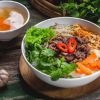
In the southern region, the soft noodles of Chinese cuisine have been transformed into chewy noodles (hu tiu dai) by the locals. It is intriguing to note that despite the long history of living alongside Vietnamese people of Chinese origin, the majority of Southerners have developed a preference for chewy noodles.
Noodle soup has gained immense popularity as a street food in Saigon - Cho Lon, with many considering it the top choice. Whether it is scorching weather or amidst polluted dust, people flock to noodle shops throughout the day and night, satiating their hunger.

Contrary to the belief that only the working class indulges in the inexpensive noodle soup served by immigrant vendors from the central provinces, renowned Nam Vang or Chinese noodle shops consistently raise their prices to keep up with inflation. These establishments are always bustling with connoisseurs, particularly on weekends. The question arises: When did the history of this beloved noodle dish begin, and how did it win over the palates of the people in Saigon?
The origin of the chewy noodle soup (Hu Tiu Dai)?
The origins of the chewy noodle soup can be traced back to Hu Tieu, a dish introduced by the Teochow and Fujian communities. In the latter half of the 17th century, the Vuong Ngan Dich group brought this culinary delight to My Tho, from where it swiftly spread to the southern provinces of Luc Tinh.

Noodles were formerly a mainstay in the meals of the majority of Vietnamese people. However, in modern-day Saigon, many young people pay little attention to the precise sorts of noodles and can't tell the difference between Chinese and Vietnamese variations. It is important to recognize the historical story of Vietnamese people from various locations and provinces.
Rice flour, which was first carried into Vietnam by Chinese immigrants and exiles, served as the base of noodle soup. The classic Chinese noodle soup, distinguished by its silky noodles, has withstood the test of time. When one went to a Chinese noodle store in the past, kindly uncles would welcome them to experience the bliss of silky noodles.
Vietnamese of Chinese heritage, whether Quang, Tieu, or Ha, typically eat soft noodles. Even for stir-fried noodles, people prefer the soft version. If kids get tired of soft noodles, rice noodles are a good substitute.
The soft strands of Chinese noodles bear a striking resemblance to those found in pho, but they possess distinct characteristics of their own. Chinese soft noodles are clear, delicate, and larger in size compared to the noodles used in pho. This similarity between Chinese soft noodles and pho has led many to consider them as "twin brothers," despite each type having its own unique name. Their resemblance is so uncanny that distinguishing between the two becomes a challenge.

Chewy noodle holds a renowned reputation across South Vietnam.
In the bustling streets and alleys of Saigon, one can find an abundance of food trucks selling noodle soups from immigrants hailing from the Central Region. When you place an order for a bowl of noodle soup, it is automatically assumed that you will be served chewy noodles, as the vendors rarely offer soft noodles. Interestingly, despite the widespread knowledge that the people from the Central Region have a strong affinity for Quang noodles, which also feature a type of noodle known as "noodles," these noodles are actually quite similar to their soft counterparts.
The unique and distinctive taste of chewy noodles has played a significant role in the birth and fame of noodle shops in various southern Vietnamese regions, including My Tho, Dong Thap, Sa Dec, and Go Cong. These noodles, typically made from rice flour, possess a distinct flavor profile that sets them apart. The quality and price of the noodles depend on the type of rice used, whether it is of good or poor quality. Notably, the noodles from My Tho, Go Cong, and Dong Thap are crafted from filtered rice flour, resulting in the creation of truly fascinating chewy noodles, an ingenious innovation by our ancestors.

Of course, the differences extend beyond just the noodles themselves. Vietnamese noodle shops employ distinct methods of cooking the broth, seasoning it, and incorporating various ingredients, setting them apart from their Chinese counterparts. It is the presence of these chewy noodles, predominantly associated with the southern regions, that adds a unique touch and enhances the diverse flavors found within Vietnamese delicacies.
Chewy noodles have not only served as a key ingredient in noodle shops, ranging from humble street stalls to upscale establishments, but they have also found their way into Southern households during festive gatherings. Whether it is a celebration or a simple get-together, Southern families often prepare delicious stir-fried noodles as a centerpiece. These noodles are paired with an array of ingredients, such as pork intestines, poultry intestines, seafood, or even vegetarian options. Those who are familiar with Southern traditions and have attended gatherings in the southern provinces of Southern Vietnam can attest that this delightful dish is always met with admiration and never goes unnoticed.
Hu Tieu, a beloved culinary delight, is readily available on every street in Saigon, ranging from humble roadside cafes to upscale dining establishments. While the North boasts its renowned noodle soup, the South takes pride in its hearty and unforgettable noodle soup experience. Saigonwalks presents an introduction to this iconic dish, emphasizing its significance for anyone fortunate enough to visit Saigon and the Southwest region. For further travel recommendations when exploring Ho Chi Minh City, be sure to follow Saigonwalks.















